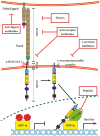Notching on Cancer's Door: Notch Signaling in Brain Tumors
- PMID: 25601901
- PMCID: PMC4283135
- DOI: 10.3389/fonc.2014.00341
Notching on Cancer's Door: Notch Signaling in Brain Tumors
Abstract
Notch receptors play an essential role in the regulation of central cellular processes during embryonic and postnatal development. The mammalian genome encodes for four Notch paralogs (Notch 1-4), which are activated by three Delta-like (Dll1/3/4) and two Serrate-like (Jagged1/2) ligands. Further, non-canonical Notch ligands such as epidermal growth factor like protein 7 (EGFL7) have been identified and serve mostly as antagonists of Notch signaling. The Notch pathway prevents neuronal differentiation in the central nervous system by driving neural stem cell maintenance and commitment of neural progenitor cells into the glial lineage. Notch is therefore often implicated in the development of brain tumors, as tumor cells share various characteristics with neural stem and progenitor cells. Notch receptors are overexpressed in gliomas and their oncogenicity has been confirmed by gain- and loss-of-function studies in vitro and in vivo. To this end, special attention is paid to the impact of Notch signaling on stem-like brain tumor-propagating cells as these cells contribute to growth, survival, invasion, and recurrence of brain tumors. Based on the outcome of ongoing studies in vivo, Notch-directed therapies such as γ-secretase inhibitors and blocking antibodies have entered and completed various clinical trials. This review summarizes the current knowledge on Notch signaling in brain tumor formation and therapy.
Keywords: Notch signaling; brain tumor therapy; clinical trials; glioma; medulloblastoma; stem-like brain tumor-propagating cells.
Figures


Similar articles
-
Notch pathway inhibition depletes stem-like cells and blocks engraftment in embryonal brain tumors.Cancer Res. 2006 Aug 1;66(15):7445-52. doi: 10.1158/0008-5472.CAN-06-0858. Cancer Res. 2006. PMID: 16885340
-
Role of Notch Signaling Pathway in Glioblastoma Pathogenesis.Cancers (Basel). 2019 Mar 1;11(3):292. doi: 10.3390/cancers11030292. Cancers (Basel). 2019. PMID: 30832246 Free PMC article. Review.
-
Distribution of presenilin 1 and 2 and their relation to Notch receptors and ligands in human embryonic/foetal central nervous system.Brain Res Dev Brain Res. 2004 Jul 19;151(1-2):75-86. doi: 10.1016/j.devbrainres.2004.04.005. Brain Res Dev Brain Res. 2004. PMID: 15246694
-
Notch ligand, JAG1, is evolutionarily conserved target of canonical WNT signaling pathway in progenitor cells.Int J Mol Med. 2006 Apr;17(4):681-5. Int J Mol Med. 2006. PMID: 16525728
-
Notch signaling in gastrointestinal tract (review).Int J Oncol. 2007 Jan;30(1):247-51. Int J Oncol. 2007. PMID: 17143535 Review.
Cited by
-
Glioblastoma stem cells and Wnt signaling pathway: molecular mechanisms and therapeutic targets.Chin Neurosurg J. 2020 Aug 3;6:25. doi: 10.1186/s41016-020-00207-z. eCollection 2020. Chin Neurosurg J. 2020. PMID: 32922954 Free PMC article. Review.
-
Common Molecular Alterations in Canine Oligodendroglioma and Human Malignant Gliomas and Potential Novel Therapeutic Targets.Front Oncol. 2019 Aug 14;9:780. doi: 10.3389/fonc.2019.00780. eCollection 2019. Front Oncol. 2019. PMID: 31475119 Free PMC article.
-
Tumour Stem Cells in Breast Cancer.Int J Mol Sci. 2022 May 2;23(9):5058. doi: 10.3390/ijms23095058. Int J Mol Sci. 2022. PMID: 35563449 Free PMC article. Review.
-
EGFR and EGFRvIII Promote Angiogenesis and Cell Invasion in Glioblastoma: Combination Therapies for an Effective Treatment.Int J Mol Sci. 2017 Jun 18;18(6):1295. doi: 10.3390/ijms18061295. Int J Mol Sci. 2017. PMID: 28629170 Free PMC article. Review.
-
Invasion of white matter tracts by glioma stem cells is regulated by a NOTCH1-SOX2 positive-feedback loop.Nat Neurosci. 2019 Jan;22(1):91-105. doi: 10.1038/s41593-018-0285-z. Epub 2018 Dec 17. Nat Neurosci. 2019. PMID: 30559479
References
-
- Yoshida J. Molecular neurosurgery using gene therapy to treat malignant glioma. Nagoya J Med Sci (1996) 59(3–4):97–105. - PubMed
-
- Gajjar A, Chintagumpala M, Ashley D, Kellie S, Kun LE, Merchant TE, et al. Risk-adapted craniospinal radiotherapy followed by high-dose chemotherapy and stem-cell rescue in children with newly diagnosed medulloblastoma (St Jude Medulloblastoma-96): long-term results from a prospective, multicentre trial. Lancet Oncol (2006) 7(10):813–20.10.1016/S1470-2045(06)70867-1 - DOI - PubMed
Publication types
LinkOut - more resources
Full Text Sources
Other Literature Sources

